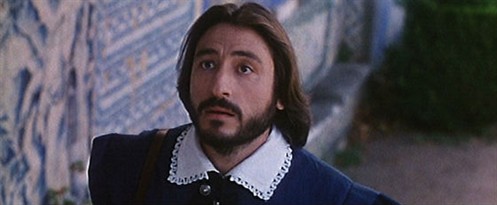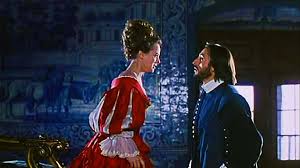
SIGNS OF ENVY. The film "El perro
del hortelano" (The Dog in the Manger", is in the theaters thanks
to the efforts of those few who believed in the project, but this
isn't the right time to make any comments other than noting that,
thanks to the film's success, a furious and profound feeling of
victory ensues.
... I let "I dare not" wait upon "I
would";" don't love, but feel a jealousy intense; know, since I
would be loved, that love I should, yet neither yield, nor offer a
defence.
Thus what I mean I show, but do not show.
Let he who can, say what I mean; I
know.
It all started with the superb
version, which Renato Castellani filmed about "Romeo and Juliet,"
winner of the Gold Lion award of the Venice Festival in 1954. Of
course it wasn't the first film ever made based on a William
Shakespeare play, but it was the first one I saw, and I saw it many
more times thereafter.
After the fascination it produced
in me that first time, every Saturday I went to the 4:00
performance at the Coliseum Theater on Gran Via Street in Madrid,
almost clandestinely, like the most unmentionable passions are
developed.
Castellani's medieval version,
starring Lawrence Harvey and Susan Shentall, is for me the most
suggestive of all that have been made about this drama of
Shakespeare. At the time, it also meant the discovery of the story
that contains all love stories, my first conscious journey into the
past, a break from the world we inhabit, towards the voices of
those who inhabited it before us, a journey more moving and magical
than we could possibly make through the best of satellites.
Watching that film repeatedly would
awaken in me a pure and generous feeling of admiration towards its
director which was repeated years later when I watched Orson
Welles' screen adaptations of Shakespeare.
GOOD FEELINGS. But the feeling was
no longer as pure and generous as before; those good feelings
gradually mixed, like in many other cases, with unquestionable
signs of envy. Perhaps the sort of envy that drives us to
investigate, to invent and, why not admit it, to emulate.
In 1989 the freshman Kenneth
Branagh dared to take on (as director and scriptwriter) a version
of Henry V, without being afraid to play the role Laurence Olivier
played in 1944, and unflinchingly using certain references from
"Chimes at Midnight", or shortly after, here in Spain, delighted a
young public with his not exactly universal movie "Much Ado
Nothing." This is when the bold question arises: So why shouldn't
we do it too? What is more, why shouldn't I give it a try?
Probably, the vitality which
theater enjoys in England has given rise to the best spectators in
the world. The speech made by Henry V that precedes the last
battle, "Today is St Crispin's day", is recited by heart by English
schoolchildren.
Here in Spain things are different. Our schoolchildren might just
about grudgingly be familiar with Calderon de la Barca's play "The
Mayor of Zalamea", and have vague doubts about his "Life is a
Dream." But, why not give it a try anyway?

THE GOLDEN AGE. It is neither easy nor comfortable to get down to
reading the works from our Golden Age and I don't think that all of
them could be successfully adapted to the screen. But I must admit
that I considered some of them before choosing to make a film from
"The Dog in the Manger, by famous playwright Lope de Vega.
Lope de Vega's verses can't be
clearer or more beautiful. They manage to have the appearance of
that which is natural, of those things that anyone can say but in a
way that only a poet like Lope can create.
However, the piece contains many sonnets and soliloquies, that is
to say, it has interior music. Hence, at first it might seem to be
anti-cinematographic, but on the other hand nobody turns his nose
up at the rhetoric in some of William Shakespeare's passages.
People don't choke on it or complain about it either, nor at the
endless verses we find in Edmond Rostand's play: Cyrano de
Bergerac.
The story about the Countess of
Belflor is most unusual. A woman, lady and master of people's wills
in the 17th century who uses her wit and position to obtain
whatever she wants, by whatever means she sees fit. A comedic
palace intrigue, caustic, malicious, intelligent and amusing.
My love, though, springs from
jealousy; distressed, although I know I'm handsomer, I see with
envy that another seems more blessed in having won a love that's
lost to me.
PILAR MIRÓ.